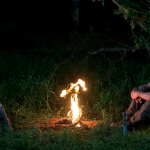After our guest post on Searching for the Wrong-Eyed Jesus, a couple of people have asked me what I would consider to be valuable reads on the topic of religion (specifically Christianity) in the American South. Here are my top five, presented in no exact order, a mix of fiction, memoir, anthropology, and history.
1. Anything by Flannery O’Connor
You had to know it was coming. After all, she is the one who coined the phrase “the Christ-haunted South.” Yet, in the very same paragraph from which that phrase originates, O’Connor writes that “almost anything you say about Southern belief can be denied in the next breath with equal propriety.”
We often use O’Connor to support stereotyped views of Southern religion as bizarre, extreme, and violent . . . all of which are adjectives that might be applied to O’Connor’s fiction. However, as a Catholic writer in the predominantly Protestant South, she found more affinity with the “freaks” and those on the fringes of white Southern society than she did with mainline Protestants: they at least shared an emphasis on the incarnational aspects of Christianity, often living it out in radically physical ways.
To get this angle of O’Connor, there’s no better story than “Parker’s Back,” in which a man has an elaborate, Byzantine icon of Christ tattooed on his back. “Revelation” is another good story to start with if you’re new to O’Connor, if only because it – like “Parker’s Back” – is a story in which no one actually gets drowned, impaled, or otherwise killed. Also, “Revelation” seems to be about my grandmother-I don’t know in what situation Flannery O’Connor might have met her, but she must have.
Of O’Connor’s two novels, The Violent Bear It Away is my favorite, though Wise Blood is more famous. If you want to understand phrases like “the Christ-haunted South,” check out Mystery and Manners, a collection of O’Connor essays and speeches. One of my favorite O’Connor books, however, is the collection of her letters called The Habit of Being. They’re hilarious, cranky, touching, and insightful. I have actually cried both times I’ve reached the end of the volume (My husband: “What’s wrong?” Me: “Flannery O’Connor just died.” My husband: “Again?”).
2. Salvation on Sand Mountain (1995), Dennis Covington
The book’s subtitle is “Snake Handling and Redemption in Southern Appalachia” . . . so, yes, like O’Connor, it does focus on the stranger manifestations of Southern religion. What makes Covington compelling is that he explores the specific social and historical circumstances that have surrounded Appalachian snake-handlers. He’s writing as a journalist, but he doesn’t remain an objective observer, instead reflecting on why he finds the snake-handlers both inspiring and frightening.
In many ways, the book is a conversion narrative: Covington does not become a snake handler (though he does take one up once), but he does come to a deeper understanding of what his own family past and his geographical location mean for his faith.
The book has amazing lyrical passages from Covington. For instance, the very last words of the book send chills down my spine (and not because of snakes): “I was always called home by my father, and he didn’t do it in the customary way. He walked down the alley all the way to the lake. . . . This is how he got me to come home. He always came to the place I was before he called my name.” It’s a beautiful metaphor for Covington’s spiritual journey, as well as our own.
3. Saving Grace (1995), Lee Smith
No, I do not have an obsession with snake-handling. In fact, I’m scared of snakes and don’t really like reading about them. As a religious practice, I think snake-handling is a terribly misguided – not to mention dangerous – reading of one Bible passage. But writers do such powerful things with snake-handling as a metaphor for the precarious walk of faith.
Lee Smith partially credits O’Connor with the inspiration for her own novel about Florida Grace Shepherd, the daughter of a hypocritical, philandering, snake-handling preacher who yet works genuine miracles. Grace herself is what O’Connor would have called a pilgrim malgré lui, a pilgrim against her will. She leads a hard life, her external circumstances sometimes resembling that of stereotypical “trailer park trash.” Yet, after a divine encounter at “Uncle Slidell’s Christian Fun Golf” (I am not making this up), she returns home to God.
4. Roadside Religion: In Search of the Sacred, the Strange, and the Substance of Faith (2005), Timothy K. Beal
I also do not have an obsession with Christian putt-putt golf courses. I feel the need to mention this because there are two Christian putt-putt courses in Roadside Religion, one with the inexplicable name of Golgotha Fun Park.
Beal is a religion scholar, but the frame of a family road-trip-as well as the eccentric subject matter-makes the book very accessible. Like some of the other writers featured here, Beal finds the most spiritual meat among the most marginalized residents of the South. (To be fair, Roadside Religion doesn’t occur exclusively in the South, but I can only recall a couple of chapters that venture above the Mason-Dixon line.)
The book is also amazingly gracious to seeming expressions of kitsch: Beal is able to view the Precious Moments Inspiration Park without scorn. His genuine openness to the workings of God through particular places and particular people humbles me.
5. Southern Cross: The Beginnings of the Bible Belt (1997), Christine Heyrman
A scholar of American religious history, Heyrman focuses on the rise of evangelicalism in the late eighteenth and early nineteenth centuries. At that time, the South was a bastion of Anglicanism (as well as slavery), and itinerant evangelical preachers were seen as spreading chaos and upheaval.
Heyrman is particularly skillful in pointing out the irony that evangelicalism was originally viewed as an “anti-family” movement, because young people rebelled and broke from their more traditional families when they converted. She also describes how evangelicalism then adapted to gain a foothold in the South. Southern Cross is an important reminder that the attitudes we associate with “Bible-Belt” Christianity today arose out of a specific, historic context-sometimes owing more to that context than they did to the radical teachings of Jesus and Paul.
There are definite limitations to this list: most obviously, I haven’t read enough about the rich history of the African American church in the South. I also have not included any Walker Percy, for the simple reason that I do not like Walker Percy (sorry to all his fans). I’m eager to hear from our readers: what would make it onto your own reading lists?











